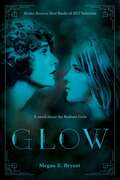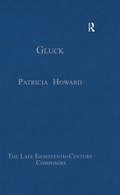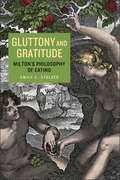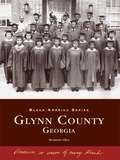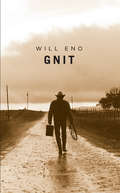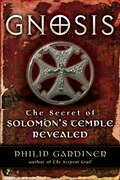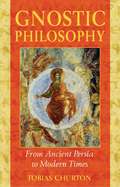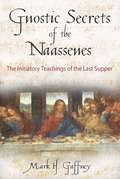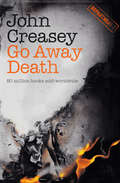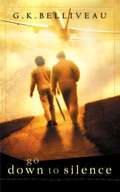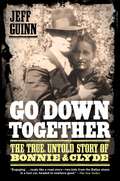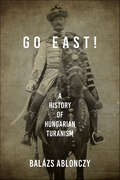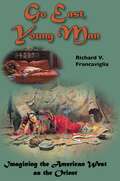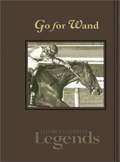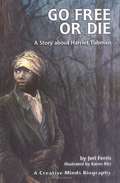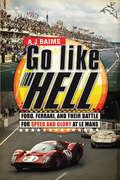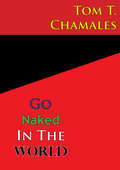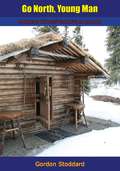- Table View
- List View
Glow: A novel about the Radium Girls
by Megan E. BryantLydia is thrilled to join the working girls in the factory, where they paint luminous watch dials for the soldiers fighting in World War I. In the future, these girls will be known as the tragic Radium Girls: factory workers not only poisoned by the glowing paint, but who also had to fight against men who knew of the paint's deadly effect. One hundred years later, Julie, whose life is on hold after high school, becomes intrigued by a series of mysterious antique paintings she finds in a thrift store. When she discovers their hidden-and increasingly nightmarish-glowing images, Julie is determined to learn more about them. As Julie's obsession mounts, truths about the Radium Girls-and her own complicated relationships-are revealed. Can she uncover the secrets behind the paintings before she puts herself and everyone she loves at risk?
Gluck: An Eighteenth-century Portrait In Letters And Documents (The\late Eighteenth-century Composers Ser.)
by Patricia HowardThis volume presents a collection of essays by leading Gluck scholars which highlight the best of recent and classic contributions to Gluck scholarship, many of which are now difficult to access. Tracing Gluck�s life, career and legacy, the essays offer a variety of approaches to the major issues and controversies surrounding the composer and his works and range from the degree to which reform elements are apparent in his early operas to his contribution to changing perceptions of Hellenism. The introduction identifies the major topics investigated and highlights the innovatory nature of many of the approaches, particularly those which address perceptions of the composer in the nineteenth and twentieth centuries. This volume, which focuses on one of the most fascinating and influential composers of his era, provides an indispensable resource for academics, scholars and libraries.
Glut: Mastering Information through the Ages
by Alex WrightWhat do primordial bacteria, medieval alchemists, and the World Wide Web have to do with each other? This fascinating exploration of how information systems emerge takes readers on a provocative journey through the history of the information age. Today's "information explosion" may seem like an acutely modern phenomenon, but we are not the first generation--nor even the first species--to wrestle with the problem of information overload. Long before the advent of computers, human beings were collecting, storing, and organizing information: from Ice Age taxonomies to Sumerian archives, Greek libraries to Dark Age monasteries. Today, we stand at a precipice, as our old systems struggle to cope with what designer Richard Saul Wurman called a "tsunami of data." With some historical perspective, however, we can begin to understand our predicament not just as the result of technological change, but as the latest chapter in an ancient story that we are only beginning to understand. Spanning disciplines from evolutionary theory and cultural anthropology to the history of books, libraries, and computer science, writer and information architect Alex Wright weaves an intriguing narrative that connects such seemingly far-flung topics as insect colonies, Stone Age jewelry, medieval monasteries, Renaissance encyclopedias, early computer networks, and the World Wide Web. Finally, he pulls these threads together to reach a surprising conclusion, suggesting that the future of the information age may lie deep in our cultural past.
Gluttony and Gratitude: Milton’s Philosophy of Eating (Medieval & Renaissance Literary Studies #1)
by Emily E. StelzerDespite the persistence and popularity of addressing the theme of eating in Paradise Lost, the tradition of Adam and Eve’s sin as one of gluttony—and the evidence for Milton’s adaptation of this tradition—has been either unnoticed or suppressed. Emily Stelzer provides the first book-length work on the philosophical significance of gluttony in this poem, arguing that a complex understanding of gluttony and of ideal, grateful, and gracious eating informs the content of Milton’s writing. Working with contextual material in the fields of physiology, philosophy, theology, and literature and building on recent scholarship on Milton’s experience of and knowledge about matter and the body, Stelzer draws connections between Milton’s work and both underexamined textual influences (including, for example, Gower’s Confessio Amantis) and well-recognized ones (such as Augustine’s City of God and Galen’s On the Natural Faculties).
Gluttony and Gratitude: Milton’s Philosophy of Eating (Medieval & Renaissance Literary Studies)
by Emily E. StelzerDespite the persistence and popularity of addressing the theme of eating in Paradise Lost, the tradition of Adam and Eve’s sin as one of gluttony—and the evidence for Milton’s adaptation of this tradition—has been either unnoticed or suppressed. Emily Stelzer provides the first book-length work on the philosophical significance of gluttony in this poem, arguing that a complex understanding of gluttony and of ideal, grateful, and gracious eating informs the content of Milton’s writing. Working with contextual material in the fields of physiology, philosophy, theology, and literature and building on recent scholarship on Milton’s experience of and knowledge about matter and the body, Stelzer draws connections between Milton’s work and both underexamined textual influences (including, for example, Gower’s Confessio Amantis) and well-recognized ones (such as Augustine’s City of God and Galen’s On the Natural Faculties).
Glynn County, Georgia (Black America Series)
by Benjamin AllenGlynn County's African-American citizenry has left an indelible mark on the history of Georgia as well as the nation. Such notable figures as Dr. Charles Wesley Buggs, renowned microbiologist; Robert Sengstacke Abbott, founder of the Chicago Defender; and Marilyn Moore Brown, an internationally praised opera singer have emerged from this picturesque coastal community. Numerous others have achieved success in education, medicine, sports, and the arts. Their engaging stories of triumph and the legacy they have created are celebrated and preserved in this unique volume.
Glória de outono e outras histórias
by Barbara MetzgerOriginalmente publicado em antologias separadas, e fora de catálogo há muitos anos, essas três novelas da lendária autora de romances da Regência, Barbara Metzger, estão em um volume pela primeira vez! Esta coleção inclui as seguintes histórias: Glória de Outono A gerência de solicitaçãoes Uma partida feita no céu - ou no inferno
Gnat Boys: True Tales from RAF, Indian and Finnish Fighter Pilots Who Flew the Single-Seat Training and Fighter Aircraft
by Tom Eeles Air Commodore Rick Peacock-EdwardsThe Folland Gnat was used by the RAF mainly in the advanced training role, in the 1960s and 70s, where it proved to be an ideal lead-in trainer for high-performance aircraft such as the iconic Lightning, the first RAF supersonic fighter. It was also the aircraft used by the famous Yellowjacks formation aerobatic team, formed in 1964, the forerunner of the world-famous Red Arrows team which was equipped with the Gnat for over a decade before being replaced by the Hawk in 1980. Lesser known, the Gnat was also used as a lightweight fighter by both the Indian and Finnish air forces. In the case of India, the Gnat, later called the ‘Ajeet’ (Midge), saw combat experience in the Indo-Pakistani wars, most notably in the Battle of Boyra. Today, over 60 years since the aircraft first flew, several Gnats continue to be operated from North Weald Airfield in Essex by the Heritage Aircraft Trust under the brand, the Gnat Display Team. This book relates the history of the aircraft and includes many fascinating and untold stories by those who flew the aircraft, many of them well-known and distinguished aviators including those from the Indian and Finnish air forces. There is also a focus on the civilian life of the Gnat in the 21st century with accounts from those who continue to fly the aircraft with the Heritage Aircraft Trust.
Gnit
by Will Eno"The marvel of Mr. Eno's new version is how closely it tracks the original while also being of the very moment and an unmistakably Will Eno play. After climbing the craggy peaks of Ibsen's daunting play, Mr. Eno has brought down from its dizzying heights a surprising crowd-pleasing (if still strange) work." - Charles Isherwood, New York Times"Gnit is classic Will Eno. By that I mean I was thrilled by it." - TimeOut Chicago"If ever a play made me want to be a better person, this is it." - Bob Fischbach, Omaha World-HeraldPeter Gnit, a funny enough, but so-so specimen of humanity, makes a lifetime of bad decisions on the search for his True Self. This is a rollicking yet cautionary tale about (among other things) how the opposite of love is laziness. Gnit is a faithful, unfaithful and willfully American misreading of Henrik Ibsen's Peer Gynt (a nineteenth-century Norwegian play), written by Will Eno, who has never been to Norway.Will Eno's most recent plays include The Open House (Signature Theatre, New York, 2014; Obie Award, Lucille Lortel Award for Best Play) and The Realistic Joneses (Yale Repertory Theatre, New Haven, 2012; Broadway, 2014). His play Middletown received the Horton Foote Prize and Thom Pain (based on nothing) was a finalist for the 2005 Pulitzer Prize. Mr. Eno lives Brooklyn.
Gnosis: The Secrets of Solomon's Temple Revealed
by Philip GardinerAn examination of the alluring mysteries surrounding the ancient temple, revealing answers to questions that have puzzled generations.Solomon’s Temple in Jerusalem—reputed to be the source of the most esoteric knowledge in human history—has fascinated scholars, seekers and dreamers for centuries. Generations of scholars and researchers have tried in vain to discover the fabled Temple of Solomon, only to be confronted by one problem after another. All the problems raised by these disparate and often desperate people have now been fully answered and can be revealed to the world.Through his own involvement in secret societies and his tenacious spirit, Philip Gardiner has unearthed the secrets of the Temple. From the Queen of Sheba and the arcane secrets of the Christian Gnostics to the Muslim Sufi and Hindu Avatars, Gnosis weaves a tale that is both profound and precise. Gardiner declares that the truth of Solomon’s Temple has been known all along within the realm of esoteric understanding. Only one question remains: Is the world ready for the truth?Find the true secret of the Knights Templar and the mysteries of the ancients. Find the truth for yourself in Gnosis.Praise for Gnosis“Controversial, provocative, even profoundly “irritating” to some. . . . Gardiner eruditely challenges us all with this refreshing study . . . from the Garden of Eden into more modern times.” —Dr. Karen Ralls, medieval historian and author of The Templars and the Grail“Gnosis is a refreshing creation of true spiritual teaching—as well as being a damn good read. Gardiner possesses that rare ability to weave history, mythology and spiritual tradition into writing that is both understandable and enjoyable. Gnosis will fascinate readers with its complex insights into spirituality.” —Gnostic Communications internet magazine“In this remarkable and thought-provoking book, Gardiner has literally undressed the sacred mystical language of our ancestors and reveals one of the most profound Biblical concepts to be exposed in recent times.” —Ernest Scott, author of The People of the Secret
Gnostic Philosophy: From Ancient Persia to Modern Times
by Tobias ChurtonAn extensive examination of the history of gnosticism and how its philosophy has influenced the Western esoteric tradition • Explains how the Gnostic understanding of self-realization is embodied in the esoteric traditions of the Rosicrucians and Freemasons • Explores how gnosticism continues to influence contemporary spirituality• Shows gnosticism to be a philosophical key that helps spiritual seekers "remember" their higher selvesGnosticism was a contemporary of early Christianity, and its demise can be traced to Christianity's efforts to silence its teachings. The Gnostic message, however, was not destroyed but simply went underground. Starting with the first emergence of Gnosticism, the author shows how its influence extended from the teachings of neo-Platonists and the magical traditions of the Middle Ages to the beliefs and ideas of the Sufis, Jacob Böhme, Carl Jung, Rudolf Steiner, and the Rosicrucians and Freemasons. In the language of spiritual freemasonry, gnosis is the rejected stone necessary for the completion of the Temple, a Temple of a new cosmic understanding that today's heirs to Gnosticism continue to strive to create.The Gnostics believed that the universe embodies a ceaseless contest between opposing principles. Terrestrial life exhibits the struggle between good and evil, life and death, beauty and ugliness, and enlightenment and ignorance: gnosis and agnosis. The very nature of physical space and time are obstacles to humanity's ability to remember its divine origins and recover its original unity with God. Thus the preeminent gnostic secret is that we are God in potential and the purpose of bona fide gnostic teaching is to return us to our godlike nature.Tobias Churton is a filmmaker and the founding editor of the magazine Freemasonry Today. He studied theology at Oxford University and created the award-winning documentary series and accompanying book The Gnostics, as well as several other films on Christian doctrine, mysticism, and magical folklore. He lives in England.
Gnostic Secrets of the Naassenes: The Initiatory Teachings of the Last Supper
by Mark H. GaffneyReveals the hidden meaning of the Grail and a secret Christian doctrine for achieving higher consciousness• Shows that Gnosticism is not a derivative of Christianity but the revelation of the true message of Jesus• Describes the ancient relationship between water and spirit• Explains the doctrine of immanence taught by Jesus at the Last Supper• Features the translated source text from The Refutation of All Heresies by Bishop Hippolytus, the only existing record of the Naassene SermonIn the third century C.E., the Catholic Bishop Hippolytus composed A Refutation of All Heresies in which his chief target was the Gnostic sect the Naassenes, whose writings included a recounting of Jesus’ actual teachings at the Last Supper. Contrary to Church attacks, the Naassenes were not a heretical derivative of Christianity but the authentic foundation and purveyor of Christ’s message. In fact, much of what passes as Christianity has nothing to do with the original teachings of its founder.The message recorded in the Naassene Sermon was intended for an inner circle of disciples who were prepared for advanced initiation into Jesus’ wisdom teachings. The Grail discussed therein was not an actual chalice but a symbol of the indwelling of the divine. The teachings involved the awakening of spirit and included practices aimed at restoring the soul’s lost connection with God. Immanence, in the true sense intended by Jesus, thus allows for spiritual attainment in this life by ordinary individuals without the intermediary of Church or priest. This was the real meaning of the Last Supper and why the Naassenes believed that Jesus was the fulfillment of all the Mystery traditions.
Go Away Death (Department Z)
by John CreaseyInternational blackmailers are scheming to rupture relations between Britain and the United States—but Bill Loftus of Department Z is hot on their trail . . .With America’s most powerful industrialists, British peers of the realm, and agents of unknown power all entangled in a conspiracy, international safety is at risk. But unraveling this global plot quickly becomes personal for Bill Loftus when the blackmailers murder someone dear to him.As things heat up and the stakes rise, Loftus must use all his professional cool to carry on with the investigation. The only question is whether the grief-stricken agent will be able to stop the criminals before the NATO alliance collapses . . .
Go Down To Silence
by G. K. BelliveauJacob Horowitz is a man with an untold story-the tale of his former life of terror and persecution at the hands of the Nazis. It's a story that may never be known, because Jacob is dying. But when the Jewish business tycoon receives an invitation to visit Pierre, a friend and former member of the Belgian underground, Jacob decides he must return once again to the land of his nightmares-and take Isaac, his estranged son, with him. In this powerful, vivid, and fast-paced narrative set alternately in the trauma of his youth and his complex present, an aging and embittered Jacob must decide whether he will reconcile with his son, his past, his God, and himself.
Go Down Together: The True, Untold Story of Bonnie and Clyde
by Jeff GuinnPrevious books and films have emphasized the supposed glamour of America's most notorious criminal couple, thus contributing to ongoing mythology. The real story is completely different—and far more fascinating.With newly discovered material, bestselling author Jeff Guin tells the real tale of two kids from a filthy Dallas slum who fell in love and then willingly traded their lives for a brief interlude of excitement and, more importantly, fame. The timing for their first heist could not have been better, when most Americans, reeling from the Great Depression, were desperate for escapist entertainment. Thanks to newsreels, true crime magazines, and new-fangled wire services that transmitted scandalous photos of Bonnie smoking a cigar to every newspaper in the nation, the Barrow Gang members almost instantly became household names. In the minds of the public, they were cool, calculating bandits who robbed banks and killed cops with equal impunity. Nothing could have been further from the truth. Clyde and Bonnie were perhaps the most inept crooks ever, and their two-year crime spree was as much a reign of error as it was of terror. Lacking the sophistication to plot robberies of big-city banks, the Barrow Gang preyed mostly on small mom-and-pop groceries and service stations. Even at that, they often came up empty-handed and were reduced to breaking into gum machines for meal money. Both were crippled, Clyde from cutting off two of his toes while in prison and Bonnie from a terrible car crash caused by Clyde's reckless driving. Constantly on the run from the law, they lived like animals, camping out in their latest stolen car, bathing in creeks, and dining on cans of cold beans and Vienna sausages. Yet theirs was a genuine love story. Their devotion to each other was as real as their overblown reputation as criminal masterminds was not. Now, thanks in great part to surviving Barrow and Parker family members and collectors of criminal memorabilia who provided Jeff Guinn with access to never-before-published material, we finally have the real story of Bonnie and Clyde and their troubled times, delivered with cinematic sweep and unprecedented insight by a masterful storyteller.
Go Down to Silence
by G. K. BelliveauJacob Horowitz, a worn and bitter business tycoon, has never spoken to anyone about his experience of Nazi persecution during World War II -- not even his recently deceased wife, Liza. Suddenly stricken with terminal cancer, the aging Jew receives an invitation from his old friend Pierre, a Gentile Christian and former Belgian underground operative, to pay him one last visit in Belgium. Jacob accepts, and determines to take along his estranged son Isaac. In this fast-paced, vivid historical account set alternately in war-torn Europe and today's United States, the consequences of war become clear. Momentous events push the hardened Horowitz toward reconciliation with his youngest son, with his past, with God, and with himself.
Go East!: A History of Hungarian Turanism (Studies in Hungarian History)
by Balázs AblonczyFor more than two centuries, Hungarians believed they shared an ethnic link with people of Japanese, Bulgarian, Estonian, Finnish, and Turkic descent. Known as "Turanism," this ideology impacts Hungarian politics, science, and cultural and ethnic identity even today. In Go East!: A History of Hungarian Turanism, Balázs Ablonczy examines the rise of Hungarian Turanism and its lasting effect on the country's history. Turanism arose from the collapse of the Kingdom of Hungary, when the nation's intellectuals began to question Hungary's place in the Western world. The influence of this ideology reached its peak during World War I, when Turanian societies funded research, economic missions, and geographical expeditions. Ablonczy traces Turanism from its foundations through its radicalization in the interwar period, its survival in emigrant circles, and its resurgence during the economic crisis of 2008. Turanian notions can be seen today in the rise of the extreme right-wing party Jobbik and in Hungarian prime minister Viktor Orbán's party Fidesz. Go East! provides fresh insight into Turanism's key political and artistic influences in Hungary and illuminates the mark it has left on history.
Go East, Young Man: Imagining the American West as the Orient
by Richard FrancavigliaTransference of orientalist images and identities to the American landscape and its inhabitants, especially in the West—in other words, portrayal of the West as the “Orient”—has been a common aspect of American cultural history. Place names, such as the Jordan River or Pyramid Lake, offer notable examples, but the imagery and its varied meanings are more widespread and significant. Understanding that range and significance, especially to the western part of the continent, means coming to terms with the complicated, nuanced ideas of the Orient and of the North American continent that European Americans brought to the West. Such complexity is what historical geographer Richard Francaviglia unravels in this book. Since the publication of Edward Said’s book, Orientalism, the term has come to signify something one-dimensionally negative. In essence, the orientalist vision was an ethnocentric characterization of the peoples of Asia (and Africa and the “Near East”) as exotic, primitive “others” subject to conquest by the nations of Europe. That now well-established point, which expresses a postcolonial perspective, is critical, but Francaviglia suggest that it overlooks much variation and complexity in the views of historical actors and writers, many of whom thought of western places in terms of an idealized and romanticized Orient. It likewise neglects positive images and interpretations to focus on those of a decadent and ostensibly inferior East. We cannot understand well or fully what the pervasive orientalism found in western cultural history meant, says Francaviglia, if we focus only on its role as an intellectual engine for European imperialism. It did play that role as well in the American West. One only need think about characterizations of American Indians as Bedouins of the Plains destined for displacement by a settled frontier. Other roles for orientalism, though, from romantic to commercial ones, were also widely in play. In Go East, Young Man, Francaviglia explores a broad range of orientalist images deployed in the context of European settlement of the American West, and he unfolds their multiple significances.
Go For Wand (Thoroughbred Legends #4)
by Bill HellerLike the great race mare Ruffian before her, Go for Wand was touched by both brilliance and tragedy. In his new book Go for Wand, part of the Thoroughbred Legend series from Eclipse Press, award-winning writer Bill Heller recounts the life of the ill-fated filly whose accomplishments on the track engendered fierce devotion from her fans. Readers will learn about Go for Wand's special relationship with her exercise rider, Rose Badgett, wife of the filly's trainer, Billy Badgett. In addition, Heller tells how hard-luck jockey Randy Romero became the only race rider Go for Wand had throughout her career, and how her owner, Mrs. Jane du Pont Lunger, came up with the filly's unusual name. On the racetrack, Go for Wand was an immediate force to be reckoned with, demolishing her fields and using her brilliant speed to propel her to victory. She was a champion at two, then at three was even better, besting her peers as well as older mares. However, it is her devastating breakdown in front of a national television audience in the 1990 Breeders' Cup that most people remember. But Go for Wand, while remembering tragedy, celebrates the brilliant filly, the one who, according to Mrs. Lunger, "raced with such joy and abandon."
Go Free or Die: A Story about Harriet Tubman
by Jeri Chase FerrisA biography of the black woman whose cruel experiences as a slave in the South led her to seek freedom in the North for herself and for others through the Underground Railroad.
Go High: The Unstoppable Presence and Poise of Michelle Obama
by M. SweeneyA photographic celebration of the elegance and inspiring strength of former First Lady Michelle Obama.Featuring more than fifty full-color photographs illustrating her warmth, wisdom, and belief in a bright future, this one-of-a-kind collection highlights Michelle Obama’s compassion, verve, and dynamic approach to unifying people from all walks of life. Each picture is accompanied by some of her most compelling words—inspirational quotes sharing her earnest belief that the United States of America is a place of unity, fairness, vitality, and optimism.A perfect gift for mothers and graduates, Go High revisits the beloved first lady’s heartfelt embrace of the American people, and her persistent encouragement to always lift one another up, reach higher, and rise to the occasion.
Go In and Sink!: riveting, all-action WW2 naval warfare from Douglas Reeman, the all-time bestselling master of storyteller of the sea
by Douglas ReemanAnother brilliantly immersive, stunning and stirring all-guns-blazing wartime thriller from multi-million copy bestselling author Douglas Reeman. Fans of Clive Cussler, Bernard Cornwell and Wilbur Smith will be gripped from page one! 'One of our foremost writers of naval fiction' -- Sunday Times'Mr Reeman writes with great knowledge about the sea and those who sail on it' --The Times'A gripping read' -- ***** Reader review'This book holds your attention from beginning to end' -- ***** Reader review'A real can't-put-down read' -- ***** Reader review'Another excellent, unputdownable story from the master storyteller, fast paced and full of just the right amount of detail, very believable characters. Get this book!' -- ***** Reader review*******************************************************************************************February 1943: As the balance of the war slowly shifts in Britain's favour, Lieutenant-Commander Steven Marshall brings his battle-scarred submarine into home port. Captain and crew are exhausted after fourteen months' continuous service, but for most there can be no thought of leave. If the enemy collapse in North Africa is to be exploited, every experienced man will be needed. Marshall must return to the Mediterranean, but this time to a very different kind of war. For his new command is secret and extremely hazardous - a captured German U-boat...
Go Like Hell: Ford, Ferrari, And Their Battle For Speed And Glory At Le Mans
by A. J. BaimeBy the early 1960s, Ford Motor Company, built to bring automobile transportation to the masses, was falling behind. Baby boomers were taking to the roads in droves, looking for speed not safety, style not comfort, and Ford didn't offer what these young drivers wanted. Meanwhile, Enzo Ferrari lorded over the European racing scene, crafting beautiful, fast sports cars that epitomized style. Baime tells the remarkable story of how Henry Ford II, with the help of a young visionary named Lee Iacocca and a former racing champion turned engineer named Carroll Shelby, concocted a scheme to reinvent the Ford company. They would enter the high-stakes world of European car racing, where an adventurous few threw safety and sanity to the wind. They would design, build, and race a car that could beat Ferrari at his own game, at the most prestigious and dangerous race in the world, the 24 Hours of LeMans. Go Like Hell transports readers to a golden era in racing when Ford's innovative strategy led to victories on the track and renewed respect for the American automobile.
Go Naked In The World
by Tom T. ChamalesA House DividedOld Pete Stratton, a theater tycoon with some shadily earned millions, is a shrewd, tough patriarch who dominates and dictates the lives of his family. In quiet rebellion, his beautiful wife, Mary, becomes a secret drinker; his daughter, Yvonne, learns about life behind her father’s back. Only his son, Nick, a battle-scarred veteran of twenty-three, dares openly to defy his father.This is the backdrop for Tom T. Chamales’ extraordinary new novel. With power and humor, the bestselling author of Never So Few charts the rebellion of a son against the tyranny of his father and the shallow confines of a wealthy world. The conflict reaches a shattering climax when Nick falls in love with the beautiful and tragic Nora, and Old Pete determines to regain control of Nick’s future by revealing that the woman his son loves is the town’s highest priced call girl....“A work marked by this writer’s passion and vividness....The novel carries us along with its compelling intensity.”—Los Angeles Times“A vivid, believable story...peopled with wonderful characters.”—Newark News“This is a big novel, almost any way you look at it—powerfully and luridly written—and a remarkable story of a passionate, hard-living Greek-American family in Chicago.”—Boston Sun Herald
Go North, Young Man: Modern Homesteading in Alaska
by Gordon StoddardFirst published in 1957, this is the story of how a young West Coaster forsakes civilization for the rugged satisfactions of homesteading in Alaska.Like many other World War II veterans, Gordon Stoddard headed up the Alcan Highway because he found civilian life too tame. He had heard of easy money in construction and fishing and he was on the lookout for adventure, but most of all he wanted a homestead.Go North, Young Man tells of his first four years as a homesteader on Alaska’s Kenai Peninsula. With wit made sharp by frontier life, he presents this exactly as he found it. Food and shelter get main attention. Leaving big game to stateside hunters, he concentrates of fish, snowshoe rabbits, spruce chickens, ptarmigan, ducks and geese: food for his larder.Guided by a ‘How to Build a Cabin’ pamphlet, he puts up his first cabin in just three days; then insulates it with cardboard cartons he picked up in Homer. Later comes the fancy cabin with its mail-order stove to keep his food, his feet, and his malamute warm. The day he installs lighting and running water causes neighborhood celebration!Not since Mark Twain has there been a writer to match him for provocative wit, originality, and the knack of catching the heady flavour of a lusty new land.
